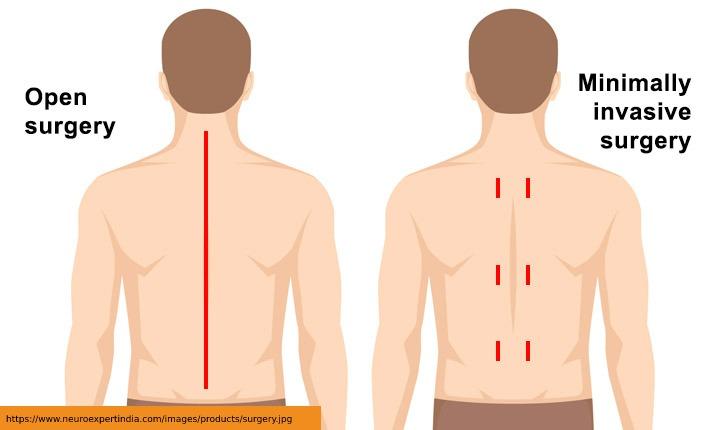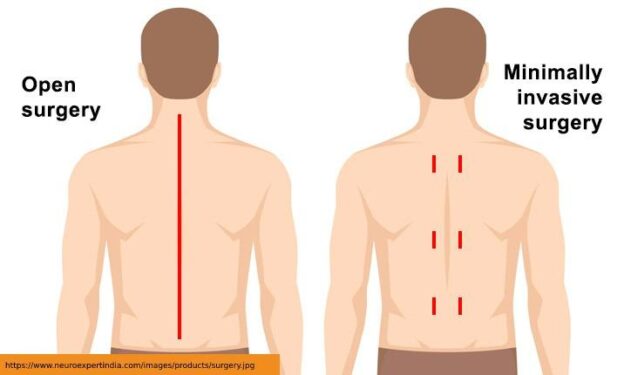Minimally invasive spine surgery is a relatively new treatment that allows surgeons to shun the traditional, open approach. By performing this procedure with a tiny incision, the surgeon can avoid disrupting muscles, nerves and blood vessels. We, humans are walking because of the muscles and the minimally invasive spine surgery will not damage the muscles unlike the traditional open surgery.
The results are dramatic: shorter operation time, less pain for the patient, and fewer complications for your surgeon. What’s even more amazing is that the best spine doctor at the best spine surgery hospital in Guntur agrees that Minimally Invasive Spine Surgery provides more benefits than traditional Surgery like less blood loss, less recovery time, faster resumption of activities, less hospital stay, e.t.c.

The first aspect of minimally invasive surgery is reducing surgical exposure to a minimum while maintaining adequate surgical exposure. A spine surgeon in Guntur has learned that a patient’s neurological function and minimizing the collateral damage during surgery are more important than anything else.
It is no longer acceptable to put patients at risk by not making every effort to preserve sensitive structures around their spinal cord. This concern has led to fewer extensive surgeries and smaller incisions which use neuronavigation, neuromontioring with precision and accuracy.
In addition, spine specialists in Guntur are now able to initiate procedures in patients who used to be considered untreatable because of their degree of disability.
Diseases Cured by Minimally Invasive Spine Surgery
- Lumbar spinal stenosis
- Spinal infections
- Spinal deformities such as scoliosis, Kyphosis
- Degenerative disc disease
- Spondyloarthritis of spine
- Cervical discectomy
- Cervical foraminotomy
- Minimally invasive spine reonstruction procedures
- Conditions that require full spinal fusion
How does Minimally Invasive Spine Surgery Works?
Minimally invasive spine surgery uses a scope to guide the surgeon during spinal operations. To perform minimally invasive spine surgery, an incision is made in the skin on either side of the spine.
The doctor inserts a scope into this incision and then uses it to manipulate and guide the surgical instruments. The scope is also used by surgeons to view internal injuries, open blood vessels and perform special procedures. Because there is less incision and only a small piece of bone removed, spinal surgeons can operate on patients who would otherwise be considered difficult cases for open procedures.

Using small incisions in combination with instrumentation allows the best spine surgeon in Andhra Pradesh to perform MIS procedures on patients. Whose vertebral bodies would have otherwise been beyond reach with traditional approaches.
These are areas such as the thoracic spine involved in lung cancer surgery. Several methods can be used to minimize trauma during MIS surgery. Some of the more common techniques are outlined here.
Use of Tubular Retractor
The tubular retractors are made of a variety of plastics or metals which are used during spine surgeries. These devices are threaded rods which the surgeon inserts through small incisions in the patient’s back to hold the vertebrae apart from each other. The retractors also allow for easy access to delicate nerves and blood vessels.
These devices ensure that certain spinal segments do not move during surgery by holding them in place. Although these devices can be used with traditional open procedures. They have been found to have great success with minimally invasive navigation solutions.
- Percutaneous Placement of Screws and Rods: The surgeon uses the above devices to create an open space through which they can operate. The surgeon inserts a small cage and then inserts pieces of titanium into it which are used to exercise the vertebrae and allow for an in-depth vision.
Percutaneous means that the surgeon is using a needle to insert rods, screws and instruments. The advantage of using the percutaneous placement of screws and rods is that they can be placed without the need for open invasive surgery. - Direct Lateral Access Routes: This is one of the most common methods used to perform MIS procedures and is similar to the lateral access approach. The patient, who is lying on their side, undergoes an X-ray or using navigation under neuromonitoring.
This procedure ensures that there are enough pathways in place to allow them to operate. After making sure that there are no significant nerves on the way to the patient’s spine, they proceed with the surgery. - Thoracoscopic Access Route: Thoracoscopic access is similar to lateral access. In this case, the surgeon uses a camera and a small needle to create an open space on the front side of the thoracic spine.
The main advantage of this method is that it averts exposure to the patient’s lungs and surrounding muscles during the procedure.
Using these minimally invasive procedures, surgeons can operate on patients who would otherwise be considered “untreatable”.
This minimally invasive technique is more effective than traditional methods in achieving results for many diseases that were previously beyond reach.
Treatment
- Endoscopic Discectomy: We are removing herniated discs with endoscopic techniques (with a small scope). This requires that the patient have an X-ray in the spinal suite which shows the disc space well enough for the surgeon to see what he needs to do. Herniated discs are removed through a small incision from above.
- Spinal decompression: We are performing spinal decompressions with a minimally invasive approach. These types of surgeries are used to treat herniated discs (which bulge or burst out of their normal location).
Another condition that can be treated with this method is spinal stenosis, which is the narrowing of the space surrounding the spinal cord or nerves. - Transforaminal Lumbar Interbody Fusion (TLIF): This is a minimally invasive procedure that is done to treat the disc disease called lumbar spinal stenosis or LSS. It is done through a small incision in the patient’s back 2 to 5 cm away from the midline.
After making sure there are no other issues in the spine, a surgeon inserts a thin Cage into the spine. And then fuses (fixation with rods and screws along with bone) several vertebrae where they have degenerated (to stabilize their structure and improve mobility).

Instruments Used
Some of the more commonly used instruments in minimally invasive spine surgery are:
–Screws: These are used to help stabilize and fuse vertebrae. They are usually made of titanium.
–Endoscope: These instruments have small heads with a camera attached to them. An endoscope is used to see the inside of the body while performing minimally invasive spine surgeries.
– Minimally invasive tubular retractor (MITR): Minimally invasive tubular retractors are used to stabilize vertebrae, mobilize the muscles out of the surgical way and allow for surgical procedure of discectomy, spinal stenosis and others.
– Discectomy retractors: Discectomy retractors are used to stabilize vertebrae, and visualize the surgical field. And protect the patient’s back during discectomy surgery.
–Bladed Spinal Instrumentation: Many different types of blades can be used during a minimally invasive surgery including spinal bars, wedges, discs and instruments that can remove bone or discs.
– Portals: Ports are small incisions that are used to improve visualization and allow for easy placement of instruments. These can be placed through the back, front or side of a patient’s body. It separates tissue during a minimally invasive surgery so that the surgeon can get a clear view of the procedure. And perform it with minimal damage to the surrounding tissue.
Spinal Fusion
Spinal Fusion is a minimally invasive spine surgery that is used to treat herniated discs or spinal stenosis. This procedure involves the removal of the disc. And then fusing it with one or more vertebral bodies to both stabilize them and increase fusion.
The main goal of this procedure is to bring the back body centre closer to the head so that it can be more flexible and easier for patients to move. The procedure requires a patient to be in good physical health, have no infection in their spine and be able to withstand stress from spinal fusion surgeries.

Final Words
Minimally invasive spine surgery is a way for patients to gain back their quality of life. It becomes a total solution to many problems or disadvantages that come with the traditional surgery and recovery process.
Minimally invasive spine surgery should be advised in patients who are willing to undergo spine surgery with less pain, less scarring, less hospital stay, immediate mobilization, less time to work and less blood loss. We, at Guntur in Andhra Pradesh providing all the minimally invasive spine surgeries with utmost care, high technology and efficient technique s at Dr. Rao’s hospital, The best neurosurgery hospital for the minimally invasive spine surgeries.



